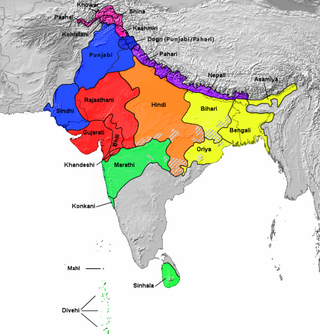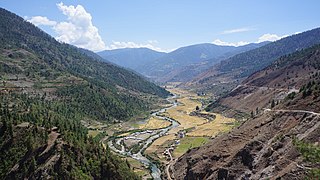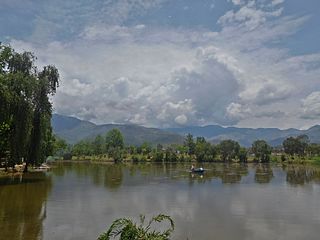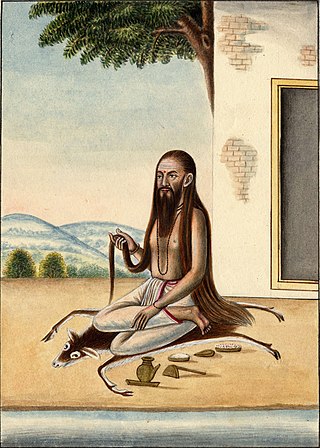
Maithili is an Indo-Aryan language spoken in parts of India and Nepal. It is native to the Mithila region, which encompasses parts of the Indian states of Bihar and Jharkhand as well as the Nepalese Koshi and Madhesh Provinces. It is one of the 22 official languages of India. It is the second most commonly spoken language of Nepal. It is also one of the fourteen provincial official languages of Nepal.

Newar or Newari, known officially in Nepal as Nepal Bhasa, is a Sino-Tibetan language spoken by the Newar people, the indigenous inhabitants of Nepal Mandala, which consists of the Kathmandu Valley and surrounding regions in Nepal.

The Northern Indo-Aryan languages, also known as Pahāṛi languages, are a proposed group of Indo-Aryan languages spoken in the lower ranges of the Himalayas, from Nepal in the east, through the Indian states of Jammu and Kashmir, Uttarakhand, Himachal Pradesh and Punjab was coined by G. A. Grierson.

Jumla District, is one of the ten districts of the Karnali province of Nepal. This district has Jumla as its headquarters, an area of 2,531 square kilometres (977 sq mi); it had populations of 89,427 and 108,921, respectively, in the national censuses of 2001 and 2011. Its territory lies between longitudes 81⁰ 28' and 82⁰ 18' East, and between latitudes 28⁰ 58' and 29⁰ 30' North.

Surkhet District is a district in Karnali Province of mid-western Nepal. Surkhet is one of the ten districts of Karnali located about 600 kilometres (373 mi) west of the national capital Kathmandu. The district's area is 2,489 square kilometres (961 sq mi). It had 288,527 population in 2001 and 350,804 in 2011 which male comprised 169,461 and female 181,381. Its district headquarters, Birendranagar, is the capital of Karnali Province. It is serving as a business hub and document center for Karnali province. According to population, development, road links, landforms, climate, many peoples are migrating here. After becoming province capital developmental activities are boosted and are in peak level. All the governmental works are carried here. Birendranagar is beautiful valley surrounded by hills having moderate climate.

Gurung, also known as Tamu Kyi or Tamu Bhāṣā, is a Sino-Tibetan language spoken by the Gurung people of Nepal. The total number of all Gurung speakers in Nepal was 227,918 in 1991 and 325,622 in 2011.

Languages of Nepal, referred to as Nepalese languages in the country's constitution, are the languages having at least an ancient history or origin inside the sovereign territory of Nepal spoken by Nepalis. The 2011 national census listed 123 languages spoken as a mother tongue in Nepal. Most belong to the Indo-Aryan and Sino-Tibetan language families.

Jumla is the centre of Chandannath Municipality in Jumla District of Karnali Province of Nepal. It is located at 2514 metres elevation.
Nepali is the national language of Nepal. Besides being spoken as a mother tongue by more than 48% of the population of Nepal, it is also spoken in Bhutan and India. The language is recognized in the Nepali constitution as an official language of Nepal.

The Tharu or Tharuhat languages are any of the Indo-Aryan languages spoken by the Tharu people of the Terai region in Nepal, and neighboring regions of Uttarakhand, Uttar Pradesh and Bihar in India.

The Sinja Valley is located in the Jumla District in Karnali Province, of Nepal. The valley was the ancient capital city of the Khasa Kingdom and is considered a historically significant place. The valley is also considered as the birthplace of Nepali language.
Dolakha Newar, or Eastern Newar, is a divergent dialect of the Newar language spoken in Dolakha District, east of the Kathmandu Valley of Nepal, by 5,645 Newar people as of 1988. Some speakers of Dolakha Newar can be found in Kathmandu for education or work.

Deuda or Deuda Khel is a Nepali genre of song and dance, performed in the Sudurpashchim and Karnali provinces of Nepal, as well as in the Kumaon Division of Uttarakhand state of India. It is performed on the occasion of various festivals, such as Gaura. The dance is performed by singing Deuda songs in a circulus by holding each-other's hands. It is considered as part of the cultural heritage of Karnali Province.
Khasa-Malla kingdom, popularly known as Khasa Kingdom and Yatse in Tibetan, was a medieval kingdom from the modern day far-western Nepal and parts of Uttarakhand state in India, established around the 11th century. It was ruled by kings of Khasa tribe who bore the family name "Malla". The Khasa Malla kings ruled western parts of Nepal during 11th–14th century. The 954 AD Khajuraho Inscription of Dhaṇga states Khasa Kingdom equivalent to Gauda of Bengal and Gurjara-Pratihara dynasty.

Nepali is an Indo-Aryan language native to the Himalayas region of South Asia. It is the official, and most widely spoken, language of Nepal, where it also serves as a lingua franca. Nepali has official status in the Indian state of Sikkim and in the Gorkhaland Territorial Administration of West Bengal. It is spoken by about a quarter of Bhutan's population. Nepali also has a significant number of speakers in the states of Arunachal Pradesh, Assam, Himachal Pradesh, Manipur, Meghalaya, Mizoram and Uttarakhand. In Myanmar it is spoken by the Burmese Gurkhas. The Nepali diaspora in the Middle East, Brunei, Australia and worldwide also use the language. Nepali is spoken by approximately 19 million native speakers and another 14 million as a second language.

Karnali Province is one of the seven federal provinces of Nepal formed by the new constitution, which was adopted on 20 September 2015. The total area of the province is 27,984 square kilometres (10,805 sq mi), making it the largest province in Nepal with 18.97% of the country's area. According to the 2011 Nepal census, the population of the province was 1,570,418, making it the least populous province in Nepal. The province borders the Tibet Autonomous Region of China to the north, Gandaki Province to the east, Sudurpashchim Province to the west, and Lumbini Province to the south. Birendranagar with a population of 154,886 is both the province's capital and largest city.

Yogi Naraharinath was a Nepali historian, writer and saint of Nath tradition of Gorakhnath. He has written over 600 books in 28 different languages and has performed 129 Koti Homs throughout Nepal.

Chaulagain is a surname in Nepal. The people of this surname belongs to Bahun and Chhetri caste. Chaulagain belongs to Bharadvaja gotra. Alternative spellings include Chamlagain, Chaulagai and Chamrel.
Sinja is a rural municipality located in Jumla District of Karnali Province of Nepal.

Bulbule Lake is a lake in Birendranagar, Karnali Province, Nepal. Bulbule lake owes its name to the way water bubbles from its spring, before it can be seen emanating from a series of stone spouts.















